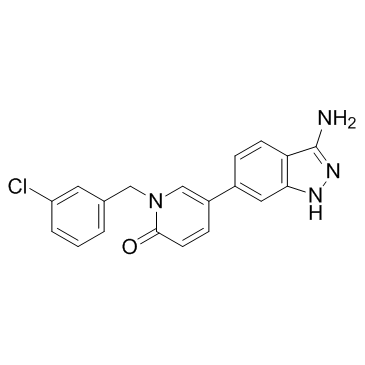| Description: |
SLV-2436 is a highly potent and ATP-competitive inhibitor of MNK1 and MNK2 with IC50s of 10.8 nM and 5.4 nM, respectively. |
| Target: |
MNK2:5.4 nM (IC50)
MNK1:10.8 nM (IC50) |
| In Vivo: |
To investigate the pharmacodynamic properties of SLV-2436 (SEL201), 5 consecutive oral doses of 10, 25, and 50 mg/kg are administered to mice every 12 hours (twice-daily schedule). At the 10 mg/kg twice-daily dosage, 4 hours after the fifth administration, a low plasma concentration of 125 ng/mL SLV-2436 is determined. However, dosing at 25 and 50 mg/kg twice daily, equivalent to 50 and 100 mg/kg/d of SLV-2436, yields substantially increased dose-dependent plasma exposure, reaching an average level of 1,299 ng/mL and 2,075 ng/mL, respectively. At the 24-hour time point, SLV-2436 is still detectable in the plasma, with dose-dependent concentrations of 9, 73, and 124 ng/mL in the 10, 25, and 50 mg/kg twice-daily treatment groups. Oral (p.o.) administration of SLV-2436 at the dosage of 50 mg/kg twice daily, that is, 100 mg/kg/d, for 37 days is well tolerated in mice[1]. |
| In Vitro: |
To confirm the kinome selectivity of SLV-2436 (SEL201), the broad KINOMEscan competitive binding assay is performed at 1 μM, which includes 450 distinct kinases. The observed binding profile for SLV-2436 is significantly concentrated in the CAMK family of kinases that comprises MNK1 and MNK2. SLV-2436-treated KIT-mutant melanoma cells have lower oncogenicity and reduced metastatic ability[1]. |
| Cell Assay: |
One thousand HBL, MM61, MM111, and M230 cell lines per well are seeded in 6-well plates, and the cells are allowed to adhere overnight. After overnight incubation, the cells are treated with either DMSO (control) or SLV-2436 (5 μM). After 14 days, media are removed from the wells, and the cells are stained with 0.5% (wt/vol) crystal violet in 70% ethanol. After 1 hour of incubation at room temperature, staining dye is washed, and the colony numbers are counted by GelCount. The experiment is done in triplicate[1]. |
| Animal Administration: |
Mice[1] The pharmacokinetic profile of SLV-2436 is assessed in 6-week-old female CD-1 mice. SLV-2436 is freshly dissolved in DMSO and then diluted in Captisol for administration with a volume of 10 μL per 1 g of body weight via the oral (p.o.; 5 mg/kg) or i.v. (2 mg/kg) route. Animals are sacrificed at 8 time points (5, 15, and 30 minutes and 1, 2, 4, 6, and 24 hours) and blood samples harvested. Plasma samples are collected and stored at -80°C for further analysis. To evaluate the pharmacodynamic properties of SLV-2436, 10- to 16-week-old male C57BL/6 mice are divided into a control group and 3 dosing groups. Animals are given either vehicle (DMSO+N,N-Dimethylacetamide+Captisol) or SLV-2436 at 10-, 25-, and 50-mg/kg doses (freshly dissolved). Drugs are administered p.o. in a volume of 10 μL per 1 g of body weight. Each animal receive a total of 5 doses with twice-daily schedule (i.e., every 12 hours). Body weight is assessed once daily. Six animals per experimental group supported sample collection at 2 time points (i.e., 4 hours and 24 hours) after the last, fifth administration, with 3 animals per time point. Plasma samples are collected and stored at -80°C for further analysis[1]. |
| References: |
[1]. Zhan Y, et al. MNK1/2 inhibition limits oncogenicity and metastasis of KIT-mutant melanoma. J Clin Invest. 2017 Nov 1;127(11):4179-4192. |

 To enhance service speed and avoid tariff delays, we've opened a US warehouse. All US orders ship directly from our US facility.
To enhance service speed and avoid tariff delays, we've opened a US warehouse. All US orders ship directly from our US facility.




















